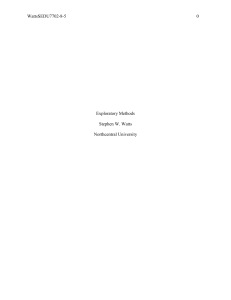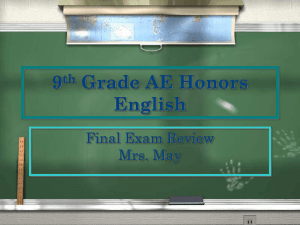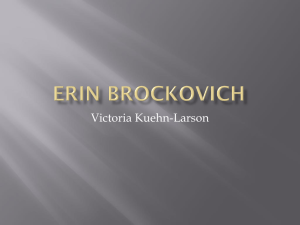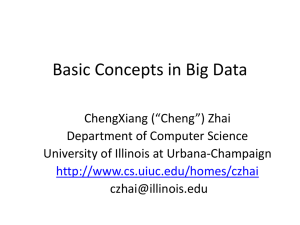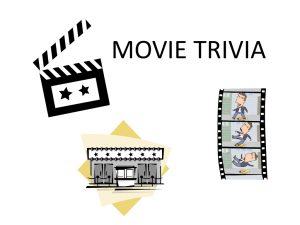Freedom Writers Movie Project
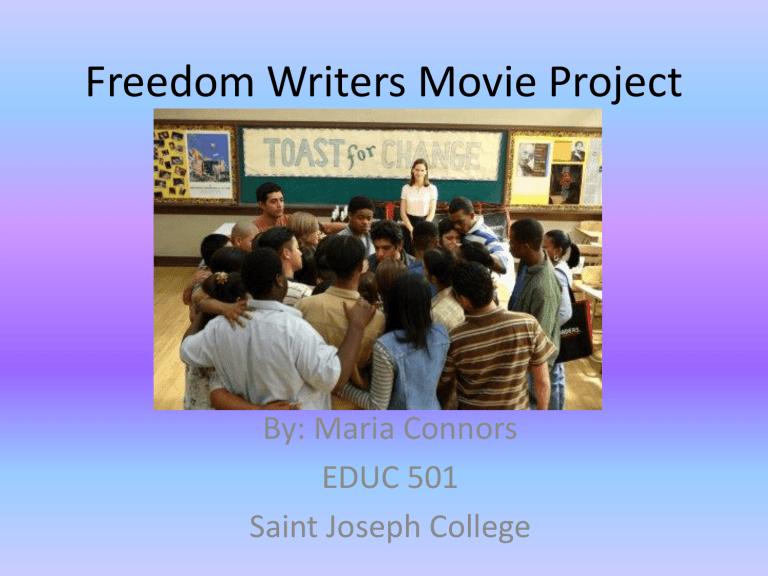
Freedom Writers Movie Project
By: Maria Connors
EDUC 501
Saint Joseph College
A Look at the Movie
• http://www.youtube.com/watch?v=oY-
KYKyFXCM
What do you think this movie is about?
The Story
• Erin Gruwell is the inspirational teacher working at
Woodrow Wilson High School in Long Beach, California.
• She works with inner-city and at-risk students, who all live pretty tough lives (e.g. gangs, family abuse, etc.).
• In the classroom, the students hate each other because of race.
• Erin Gruwell helps the students find themselves (i.e. their identity), work to their best potential, and realize that they are all similar.
• However, Erin’s battle isn’t just with the students, but it is also with the school too.
What is Your Impression?
Eva: “In America, a girl can be crowned a princess for her beauty and her grace. But an Aztec princess is chosen for her blood…to fight for her people, as Papi and his father fought against those who say we are less than they are, who say we are not equal in beauty and in blessings. “
Development
Personal Development: “Development, with age, of distinctive behavioral styles and increasingly complex self-understandings” (Ormrod, 2011, p. 62).
Social Development: “Development, with age, of increasingly sophisticated understandings of other people and of society as a whole, as well as increasingly effective interpersonal skills and more internalized standards for behavior” (Ormrod, 2011, p. 62).
Authoritarian Parenting: “Parenting style characterized by rigid rules and expectations for behavior that children are asked to obey without question”
(Ormrod, 2011, p. 63).
Child Maltreatment: “Consistent neglect or abuse of a child that jeopardizes the child’s physical and psychological well-being” (Ormrod, 2011, p. 64).
Socialization: “Process of molding a child’s behavior and beliefs to be appropriate for his or her cultural group” (Ormrod, 2011, p. 65).
Development (cont.)
Development is represented in the movie by:
• The students in the class were split up based on race.
• The racial tension began from the home environment
(i.e. parents’ beliefs).
• Gang life (e.g. Eva joined a gang – 3 rd generation).
• Each student follows his or her’s ethnic groups beliefs
(e.g. “At least when you die for your own, you die with respect, you die a warrior” ~ Marcus and Eva’s predicament with the trial).
• Students are abused by their parents (e.g. Sindy’s family,
Gloria’s family, and Brandy’s family).
“When I look out in the world, I don’t see nobody that looks like me with their pockets full, unless they’re rapping a lyric or dribbling a ball.” ~ Marcus
Diversity and Ethnicity
Culture: “Behaviors and belief systems of a long-standing social group” (Ormrod, 2011, p. 104).
Ethnic Group: “People who have common historical roots, values, beliefs, and behaviors and who share a sense of interdependence” (Ormrod, 2011, p. 105).
Acculturation: “Gradual process of adopting the values and customs of a new culture” (Ormrod, 2011, p. 105).
Worldview: “General, culturally based set of assumptions about reality that influence understandings of a wide variety of phenomena” (Ormrod, 2011, p. 113).
Diversity and Ethnicity (cont.)
Strategies:
• “Educate yourself about your students’ cultural backgrounds”
(Ormrod, 2011, p. 114).
• “Work hard to break down students’ stereotypes of particular ethnic groups” (Ormrod, 2011, p. 115).
• “Foster democratic ideals, and empower students to bring about meaningful change” (Ormrod, 2011, p. 116).
Bridging the gap…
• Discussion about the prejudiced picture that was drawn of Jamal.
• She conducted the line game to bring the students closer by making them aware of their similarities to each other.
• She read the journals of the students.
• Field trip to the Museum of Tolerance and dinner with Holocaust survivors.
• Miep Gies’ visit to their school.
Diversity and Ethnicity (Cont.)
Student at risk: “Student with a high probability of failing to acquire minimal academic skills necessary for success in the adult world” (Ormrod, 2011, p. 130).
Strategies:
• “Create a warm, supportive school and classroom atmosphere” (Ormrod, 2011, p. 132).
• “Encourage and facilitate identification with school”
(Ormrod, 2011, p. 132).
Bridging the gap…
• Journals of students
• Talks with students before, during, and after school
• Field Trip
• “Toast for Change”
• Students’ decision to raise money for Miep Gies to visit their school (e.g. food festival and dance concert) .
What is Your Impression?
Erin: “We’re each gonna make a toast for change. And what that means is, from this moment on every voice that told you “You can’t” is silenced. Every reason that tells you things will never change, disappears. And the person you were before this moment, that person’s turn is over. Now it’s your turn.”
Motivational Strategies
Resilient student: “Student who succeeds in school and in life despite exceptional hardships at home” (Ormrod, 2011, p. 128).
Strategies:
• “Be a dependable source of academic and emotional
support” (Ormrod, 2011, p. 128).
• “Provide opportunities for independent work and decision
making” (Ormrod, 2011, p. 369).
• Hidi & Renninger and McDaniel, Waddill, Finstad, & Bourg (as cited in Ormrod, 2011) explained that students are especially motivated and attentive when they are interested in a subject or concept.
• Need for self-determination: “basic need to believe that one has some autonomy and control regarding the course of one’s life” (Ormrod, 2011, p. 368).
Motivational Strategies (Cont.)
Erin’s motivational strategies:
• Talks with students before, during, and after school (e.g. Eva in trouble with ethnic group after trial and talk with Eva and Marcus about The Diary of Anne Frank book).
• Students made the decision to raise money for Miep Gies to visit school.
• Students gave themselves a grade (e.g. Andre’s grade).
• Erin selected books that related to the students (e.g. book about a boy in a gang).
• Erin used a Tupac song to teach poetry.
• The Freedom Writers Diary (e.g. students type their diaries into one book)
• “Toast for Change”
What is Your Impression?
Ms. Campbell: “You can’t make someone want an education. The best you can do is try to get them to obey, to learn discipline. That would be a tremendous accomplishment for them.”
Teaching Strategies
Teaching Strategies:
• Discovery Learning: “Approach to instruction in which students derive their own knowledge about a topic through firsthand interaction with the environment” (Ormrod, 2011, p. 430).
• In-Class Assignments: “completing worksheets, solving problems, writing lab reports, acting out short stories, and so on” (Ormrod, 2011, p. 432).
• Computer Tool Applications: “word processing, desktop publishing, databases, and spreadsheets” (Ormrod, 2011, p. 434).
Teaching Strategies (Cont.)
Examples of Erin’s Teaching Strategies:
• Field trip to the Museum of Tolerance and dinner with Holocaust survivors.
• Letter to Miep Gies
• Debate
• Movie (e.g. Movie about an interracial civil rights group and Jim Zwerg)
• The Freedom Writers Diary (e.g. students type their diaries into one book)
Our Toast for Change
• What can you do to make a change in your teaching profession (i.e. current or future)?
References
• DeVito, D. (Producer), & LaGravenese, R.
(Director). (2007). Freedom Writers
[Motion picture]. United States: Paramount
Pictures.
• Ormrod, J.E. (2011). Educational psychology:
Developing learners (7 th ed.). Boston:
Pearson.

